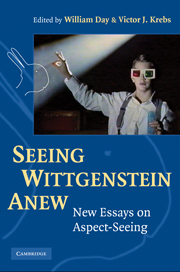Book contents
- Frontmatter
- Contents
- List of Contributors
- Acknowledgments
- Abbreviations of Wittgenstein's Works
- Seeing Wittgenstein Anew
- Introduction: Seeing Aspects in Wittgenstein
- I ASPECTS OF “SEEING-AS”
- 1 Aesthetic Analogies
- 2 Aspects, Sense, and Perception
- 3 An Allegory of Affinities
- 4 The Touch of Words
- II ASPECTS AND THE SELF
- III ASPECTS AND LANGUAGE
- IV ASPECTS AND METHOD
- Appendix: A Page Concordance for Unnumbered Remarks in Philosophical Investigations
- List of Works Cited
- Index
1 - Aesthetic Analogies
Published online by Cambridge University Press: 05 June 2012
- Frontmatter
- Contents
- List of Contributors
- Acknowledgments
- Abbreviations of Wittgenstein's Works
- Seeing Wittgenstein Anew
- Introduction: Seeing Aspects in Wittgenstein
- I ASPECTS OF “SEEING-AS”
- 1 Aesthetic Analogies
- 2 Aspects, Sense, and Perception
- 3 An Allegory of Affinities
- 4 The Touch of Words
- II ASPECTS AND THE SELF
- III ASPECTS AND LANGUAGE
- IV ASPECTS AND METHOD
- Appendix: A Page Concordance for Unnumbered Remarks in Philosophical Investigations
- List of Works Cited
- Index
Summary
Wittgenstein's remarks about “seeing-as” in Part II, Section 11 of Philosophical Investigations are not in the first place about matters of aesthetics. He begins his discussion in that section by noting a distinction (a “difference of category”) between what he calls “two ‘objects’ of sight.” The distinction is between what you can be said to see when you say, simply, “I see this” and give a description or draw or point to something, and what you can be said to see when you declare “a likeness” between two objects. He calls the last sort of seeing “noticing an aspect.”
Wittgenstein says that he is interested in “the concept [of noticing an aspect] and its place among the concepts of experience” (PI 193e). He notes this by way of explaining how his interest in this sort of seeing is different from that of psychologists (“Its causes are of interest to psychologists”). He then introduces an example of a geometric figure that we can see first as one thing and then as another (“here a glass cube, there an inverted open box, there a wire frame of that shape,” and so on) when we encounter it in different places in a “text-book,” accompanied in each place by a different interpretation. The particular example (a simple line drawing) with its particular range of interpretations (“glass cube, … inverted open box, … wire frame …”) is something, I suppose, that we might find in a textbook in psychology (perhaps with “picture objects” and Jastrow's “duck-rabbit”).
Keywords
- Type
- Chapter
- Information
- Seeing Wittgenstein Anew , pp. 23 - 39Publisher: Cambridge University PressPrint publication year: 2010
- 2
- Cited by

